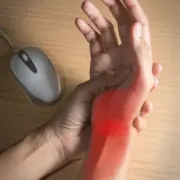How long does carpal tunnel last?
Carpal tunnel syndrome causes pain, weakness and numbness or tingling in your palm, fingers, and even your wrist and arm. It’s caused by compression of the median nerve which runs from your hand between tendons and a ligament that together comprise the “carpal tunnel” and continues on all the way up your arm.
Carpal tunnel tends to develop gradually and get worse with time. It is treatable, and how long it lasts really depends on how quickly you adjust your wrist movements or seek treatment.
The syndrome is often caused by repetitive motion that leads to nerve compression, and without treatment, the pain, tingling or weakness in your thumb and fingers usually persists. If these symptoms are ignored, your case could become severe, causing loss of sensation for heat or cold or even severe muscle deterioration at the base of the hand.
If you have symptoms that you think could be carpal tunnel syndrome, it’s a good time to talk to an orthopedic specialist. The earlier you get a proper diagnosis, the faster you can experience relief and reduce the potential for long-term damage.
If you suspect carpal tunnel, there are a few things that might help to minimize your symptoms prior to your appointment. But remember, these options only reduce symptoms, rather than treating the actual carpal tunnel syndrome:
Rest: If there’s a repetitive activity that causes your symptoms to present or flair up, there’s a good chance that some repetitive motion within that activity– like typing, writing, or squeezing – is contributing to your symptoms. Try to take frequent breaks or eliminate the activity altogether if possible.
Knowing that it’s not realistic for many to stop a motion that’s required for work or other daily activities, rest, or making some kind of moderating accommodation is key. This may include using a wrist pad next to your computer keyboard or temporarily changing your technique for other activities.
Ice or NSAIDs: Icing for 10-15 minutes at a time every few hours can relieve the symptoms temporarily. Non-steroidal anti-inflammatory drugs (NSAIDs) such as ibuprofen can also temporarily reduce inflammation and pain.
Treatment naturally varies for each person, so what works best for you might not be as effective for someone else. That’s why it’s so important to see a hand and wrist specialist sooner rather than later so they can recommend the right regimen of treatment.
This will depend on the type and severity of your specific symptoms. A hand and wrist doctor will can recommend and provide myriad other treatments that go far beyond self-care.
Options include non-surgical treatment such as:
Bracing or splinting to stabilize the wrist while it’s in use – or at night, to keep you from bending it.
Physical therapy, including exercises known as “nerve gliding” or “nerve flossing.” These exercises work to gently stretch the median nerve and help it move more smoothly through the carpal tunnel. Your hand and wrist doctor may suggest other therapy depending on your diagnosis.
Steroid injections can relieve symptoms but are not a long-term treatment of carpal tunnel syndrome. The anti-inflammatory power of the steroid cortisone can help calm the nerve and can also be used to diagnose the syndrome.
If your case is severe, surgery may be recommended, and the recovery tends to be gradual.
Carpal tunnel release surgery relieves the median nerve pressure. In this procedure, the surgeon cuts the ligament that serves as the top of the tunnel.
Surgery is very successful for most patients, but full recovery can take as long as a year. This includes the strength of your grip, which many patients regain 6-12 months after surgery.
Are you experiencing symptoms of carpel tunnel? See a hand and wrist specialist in Colorado Springs at Colorado Center of Orthopedic Excellence. Call for an appointment at 719-623-1050.



